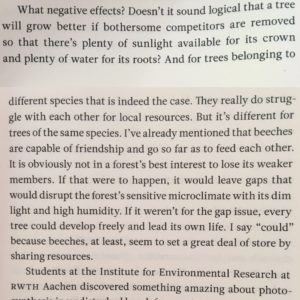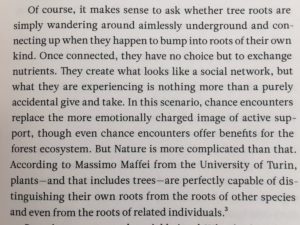Just substitute “Jews” for everything bad in this article and you can see how this essay is an invite for a Holocaust. It is stoking the flames of hate.
This is not who we are. It’s the current year. My wife’s son is very upset.
Substitute “whites” or “goyim” or “WASPs” for leafy trees and you’ll be clued in to the white supremacy inherent in the system.
How long will we stand by while foreign eucalypti devastate our native habitat and suck up our water?
I’m from Australia but I’m sick of eucalypti running everything in this town.
Why can’t there be a patch of this earth that is free from invasive species? Why can’t Southern California native plants have their own safe space?
The WASPs that made America great are dying. Fast.
The whites that shade, cool, and subsidize invasive species from around the world are dying. Fast.
We are witnessing a transition to a post-oasis landscape in Southern California as the natives are displaced by the growing brown tide.
Catastrophic loss of our goyim (white Christians of European ancestry) canopy would have consequences for human health and well-being, property values, air-conditioning savings, carbon storage, the removal of pollutants from the air we breathe, and wildlife habitat.
Jerrold Tu, pathologist for Los Angeles County, likened the surge in white mortality to “watching a train wreck in slow motion.”
Funny how it is cool to care about trees, but uncool to care about whites and Western civilization (the product of white goyim of Christian origins).
From The Hidden Life of Trees by Peter Wohlleben:
@lukeford I like this approach. Did you know trees communicate with members of their own species? Guess how. Through the #roots.
— CP 3.0 (@CdotPRATT) April 21, 2017
The trees that make Southern California shady and green are dying. Fast.
The trees that shade, cool and feed people from Ventura County to the Mexican border are dying so fast that within a few years it’s possible the region will look, feel, sound and smell much less pleasant than it does now.
“We’re witnessing a transition to a post-oasis landscape in Southern California,” says Greg McPherson, a supervisory research forester with the U.S. Forest Service who has been studying what he and others call an unprecedented die-off of the trees greening Southern California’s parks, campuses and yards.
Botanists in recent years have documented insect and disease infestations as they’ve hop-scotched about the region, devastating Griffith Park’s sycamores and destroying over 100,000 willows in San Diego County’s Tijuana River Valley Regional Park, for example.
“It’s heartbreaking to see trees dying in such dramatic numbers in famously lush cities like Pasadena, Alhambra and Arcadia.”
— Jerrold Turney, plant pathologist for Los Angeles County.…And that insect is just one of the imminent threats.
“Many of the trees we grow evolved in temperate climates and can’t tolerate the stress of drought, water restrictions, higher salinity levels in recycled water, wind and new pests that arrive almost daily via global trade and tourism, local transportation systems, nurseries and the movement of infected firewood,” he said.
“There will be no miraculous recovery of these urban ecosystems after the beetles are done with them.”
— Mark Hoddle, director of UC Riverside’s Center for Invasive Species.
But Southern Californians would face many other costs.
“Catastrophic loss of our canopy,” McPherson said, “would have consequences for human health and well-being, property values, air-conditioning savings, carbon storage, the removal of pollutants from the air we breathe, and wildlife habitat.”
Jerrold Turney, plant pathologist for Los Angeles County, likened the surge in urban tree mortality to “watching a train wreck in slow motion.”
“It’s heartbreaking,” he said, “to see trees dying in such dramatic numbers in famously lush cities like Pasadena, Alhambra and Arcadia: sycamores, all the maples, olives, liquidambers, flower plums, myrtles, oleanders and oaks.”
Mark Hoddle, director of UC Riverside’s Center for Invasive Species, said that the tree loss is “starting to cascade across the urban landscape.”
“Without shade trees, water temperatures will rise and algae will bloom in riparian areas, for instance,” Hoddle said. “As a result, fish, frog and native insect populations will diminish, along with the pleasure of hiking, because there’ll be nothing to look at but dead boughs of trees.”
“And,” he added, “there will be no miraculous recovery of these urban ecosystems after the beetles are done with them.”
Among the hardest-hit native species of urban trees are California sycamores, typically found along streams and commonly used as shade and street trees in places such as Griffith Park and along downtown’s Wilshire Boulevard.
“Here’s the sad news about sycamores,” said Akif Eskalen, a plant pathologist at the University of California, Riverside. “If we cannot control the shot hole borer, it will kill all the sycamores in California. And when they’re done with sycamores, they’ll move to other trees.”
By 2012, pathologists knew that the shot hole borer was transmitting a fatal fungal disease to 19 species of trees in Southern California, he said. Since then, scientists have identified 30 additional host species.
“If we cannot control the shot hole borer, it will kill all the sycamores in California.”
— Akif Eskalen, plant pathologist at the University of California, Riverside.


